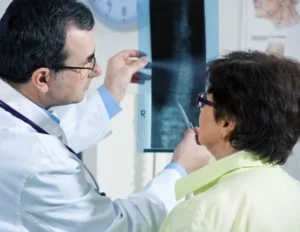Deep Learning Revolutionizes COPD Diagnosis with Single CT Scan, Reducing Patient Burden
Chronic Obstructive Pulmonary Disease (COPD) is one of the most prevalent and debilitating lung diseases worldwide. It is characterized by persistent respiratory symptoms such as breathlessness, chronic cough, and mucus production. COPD often results from long-term exposure to irritants like cigarette smoke, air pollution, and occupational dust. The disease is progressive, and early diagnosis is critical for slowing its progression and improving patient outcomes. Traditionally, the diagnosis of COPD involved a combination of clinical evaluation, spirometry tests, and imaging techniques like chest X-rays and CT scans. However, diagnosing COPD has often been a time-consuming and burdensome process for patients, particularly as it typically requires multiple tests and repeated visits to healthcare facilities.
The recent advent of deep learning in medical imaging has revolutionized the approach to diagnosing COPD, offering a more efficient, accurate, and less invasive alternative. Deep learning models, a subset of artificial intelligence (AI), have been trained to analyze medical images such as CT scans, enabling the detection of COPD with remarkable precision. By analyzing a single CT scan, deep learning algorithms can now detect COPD and even predict its severity, offering a groundbreaking shift in how the disease is diagnosed and managed. This technological advance is transforming COPD diagnosis, reducing the patient burden and providing healthcare providers with powerful tools to improve patient care.
Understanding Chronic Obstructive Pulmonary Disease (COPD)
COPD is a progressive lung disease that primarily affects the elderly and individuals with a history of smoking. The disease causes airflow obstruction, which leads to difficulty in breathing, wheezing, and persistent coughing. Over time, COPD can significantly impair a person’s ability to perform daily tasks and severely impact their quality of life. The global prevalence of COPD is high, and it remains a leading cause of death worldwide. According to the World Health Organization (WHO), COPD is the third leading cause of death globally, with millions of people affected by the disease.
COPD is often diagnosed in the later stages of the disease, as its symptoms may develop gradually, and many individuals may not seek medical attention until the disease has already progressed. Early diagnosis is crucial, as it allows for timely interventions, including smoking cessation, pharmacological treatments, and lifestyle changes, which can slow disease progression and improve quality of life. Traditional diagnostic methods rely on a combination of patient history, physical examination, spirometry (a test that measures lung function), and imaging techniques such as X-rays and CT scans.
Traditional COPD Diagnosis: Challenges and Limitations
Traditional methods of diagnosing COPD involve a detailed medical history, physical examination, and the use of spirometry, which is the gold standard test for diagnosing airflow obstruction. However, spirometry has limitations, as it requires patients to perform specific breathing maneuvers, which may be difficult for individuals with severe symptoms. Additionally, spirometry cannot always detect early-stage COPD, and false negatives are common, especially in patients with mild symptoms.
Imaging techniques, such as chest X-rays, are also commonly used to assess the lungs in COPD patients. While chest X-rays can reveal certain lung changes associated with COPD, they have limited sensitivity and may not detect early or subtle signs of the disease. High-resolution CT (HRCT) scans offer greater detail and sensitivity, providing a more accurate picture of lung structure and function. However, the interpretation of CT scans requires expert radiologists, and the process can be time-consuming and expensive, particularly in resource-limited settings.
Moreover, traditional diagnostic methods often require multiple visits to healthcare facilities, causing significant inconvenience and stress for patients. Many individuals, especially those in rural or underserved areas, may struggle with accessing specialized diagnostic services, further delaying diagnosis and treatment.
The Rise of Deep Learning in Medical Imaging
Deep learning is a subset of machine learning, a branch of artificial intelligence (AI), that has revolutionized the field of medical imaging. Deep learning models, particularly convolutional neural networks (CNNs), have shown great promise in analyzing medical images with high accuracy, often surpassing human experts in certain tasks. CNNs are designed to automatically detect patterns in images by mimicking the way the human brain processes visual information. By training these models on vast datasets of labeled images, deep learning algorithms can learn to identify specific features, abnormalities, and conditions in medical images such as CT scans, MRIs, and X-rays.
In the context of COPD diagnosis, deep learning algorithms are trained to analyze CT scans of the lungs and identify subtle changes in lung tissue that may indicate the presence of COPD. These changes may include airway narrowing, emphysema (damage to the lung tissue), and other structural abnormalities. By learning from thousands of labeled CT scans, deep learning models can become highly adept at detecting COPD and its severity, often at an earlier stage than traditional methods.
One of the most significant advantages of deep learning in COPD diagnosis is its ability to analyze CT scans in a matter of seconds, providing quick and accurate results. This not only reduces the time required for diagnosis but also eliminates the need for multiple visits or tests, reducing the burden on patients. Additionally, deep learning models can identify patterns that may be missed by human radiologists, leading to more accurate and reliable diagnoses.
How Deep Learning Improves COPD Diagnosis
The application of deep learning in COPD diagnosis is revolutionizing the field in several key ways:
- Automated Analysis of CT Scans: Traditional methods of COPD diagnosis require manual interpretation of CT scans by radiologists, which can be time-consuming and subject to human error. Deep learning algorithms can automatically analyze CT scans in seconds, providing an accurate diagnosis with minimal human intervention. These models can identify early signs of COPD that may not be visible to the naked eye, allowing for earlier detection and intervention.
- Increased Accuracy and Sensitivity: Deep learning algorithms have been shown to outperform traditional methods in detecting COPD. By learning from large datasets of CT scans, deep learning models can recognize subtle patterns in lung tissue that may indicate the presence of COPD. This increased sensitivity allows for the detection of early-stage disease, which is critical for improving patient outcomes.
- Reduced Patient Burden: Traditional COPD diagnosis often requires multiple visits to healthcare facilities, including spirometry tests, chest X-rays, and follow-up appointments with specialists. Deep learning-based analysis of a single CT scan can significantly reduce the number of tests required, allowing for a faster and more efficient diagnosis. Patients no longer need to undergo multiple procedures, reducing the time, cost, and physical strain associated with traditional diagnostic methods.
- Predicting Disease Severity: Deep learning models can not only detect the presence of COPD but also assess its severity. By analyzing the extent of lung damage and airway narrowing, deep learning algorithms can provide valuable information about the stage of the disease, helping healthcare providers tailor treatment plans. This predictive capability is particularly important for managing COPD progression and preventing complications.
- Improved Access to Healthcare: In many parts of the world, access to specialized healthcare services, including radiologists and pulmonologists, is limited. Deep learning algorithms can be integrated into telemedicine platforms, allowing healthcare providers in remote areas to analyze CT scans and diagnose COPD without the need for specialist consultations. This improved access can lead to earlier detection and more equitable healthcare delivery.
The Role of AI in COPD Management
In addition to its diagnostic capabilities, deep learning can also play a critical role in the ongoing management of COPD. AI-powered tools can be used to track disease progression, predict flare-ups, and optimize treatment plans. For example, AI models can analyze data from wearable devices, such as pulse oximeters and spirometers, to monitor lung function in real-time and alert patients and healthcare providers to potential issues. This proactive approach to COPD management can help prevent exacerbations and hospitalizations, improving patient outcomes and reducing healthcare costs.
Furthermore, AI-driven decision support tools can assist healthcare providers in choosing the most appropriate treatments for COPD patients. By analyzing a patient’s medical history, comorbidities, and diagnostic data, AI models can recommend personalized treatment plans that maximize efficacy and minimize side effects.
Future Directions and Challenges
While the use of deep learning in COPD diagnosis has shown tremendous promise, there are still challenges to overcome. One key challenge is the need for large, diverse datasets to train deep learning models. The success of AI algorithms depends on the quality and quantity of data, and access to comprehensive, annotated datasets is essential for improving model performance. Additionally, ensuring that deep learning models are interpretable and transparent is crucial for building trust among healthcare providers and patients.
Another challenge is the integration of AI-based tools into existing healthcare systems. Widespread adoption of deep learning for COPD diagnosis will require collaboration between healthcare providers, AI developers, and regulatory bodies. Standardization of AI algorithms and integration with electronic health records (EHRs) will be essential for seamless implementation.
Despite these challenges, the future of deep learning in COPD diagnosis and management looks promising. As technology continues to evolve, AI-powered tools will play an increasingly important role in providing faster, more accurate diagnoses and improving patient care.
The application of deep learning in COPD diagnosis is a game-changer for both patients and healthcare providers. By automating the analysis of CT scans, deep learning algorithms can provide faster, more accurate diagnoses, reducing the burden on patients and improving outcomes. As the technology continues to advance, AI-driven tools will revolutionize the way COPD is diagnosed, managed, and treated, offering new hope for individuals living with this debilitating disease. With the potential to increase early detection, reduce healthcare costs, and improve access to care, deep learning is paving the way for a future where COPD is more effectively managed and treated.














